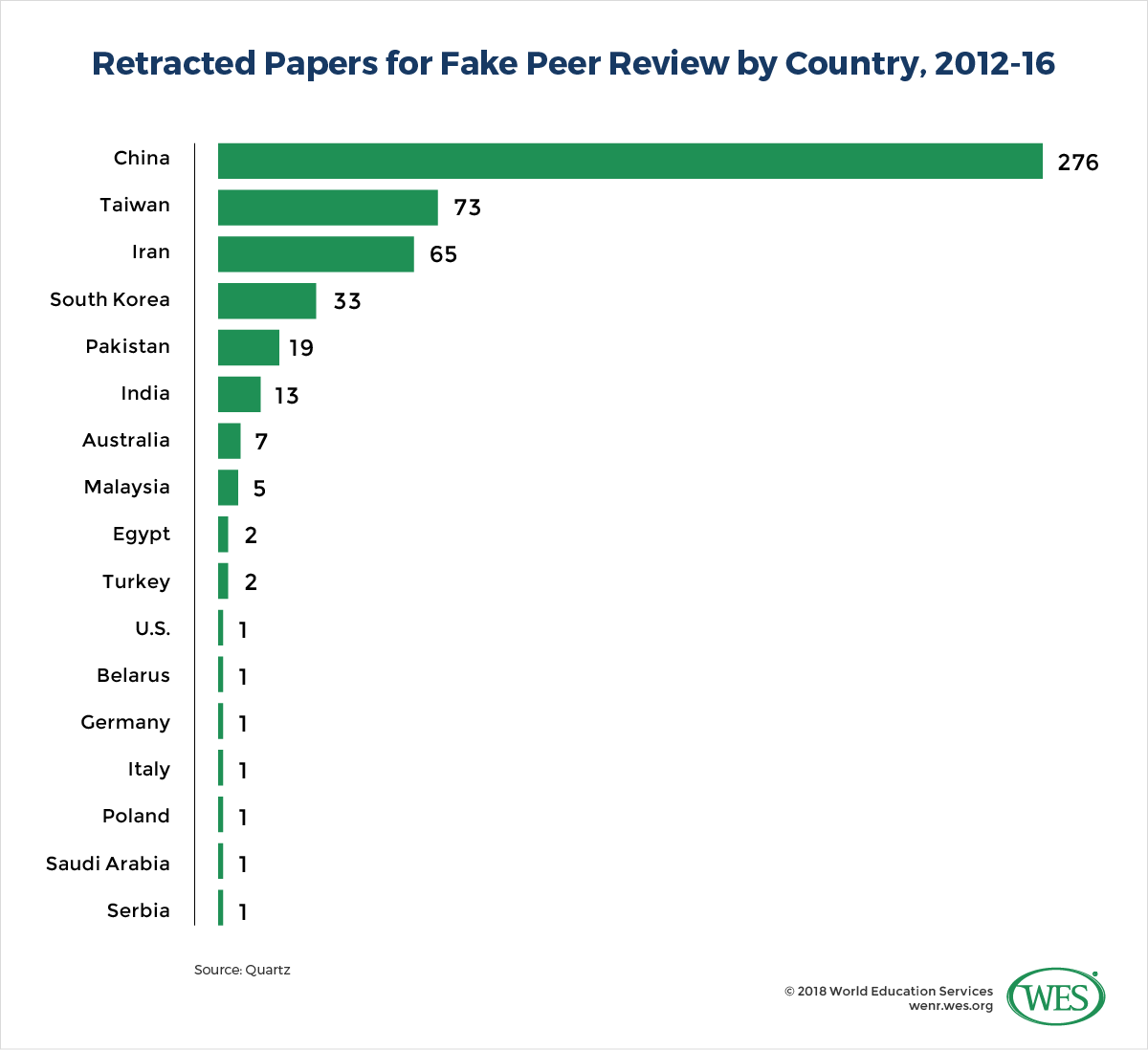The Economy of Fraud in Academic Publishing in China
Mini Gu, Advanced Evaluation Specialist, WES
In 2012, the administration of Chinese President Xi Jinping launched a far-reaching campaign to root out corruption in China’s state bureaucracy. In 2017 alone, 527,000 civil servants were disciplined for corruption-related offenses.
The crackdown reflects the reality that the rapid economic growth in China over the past decades has been accompanied by increasing levels of corruption. In what has been described as “the dark side of China’s rise,” the market reforms in the Middle Kingdom have allowed crony capitalism and endemic corruption to spread. Despite the current efforts to combat corruption, China’s rank in Transparency International’s (TI) “Global Corruption Perceptions Index” has barely improved since 2012. In surveys conducted by TI between 2015 and 2016, almost three-quarters of Chinese respondents reported that corruption in China had, in fact, increased over the previous three years.
Aside from undermining the political legitimacy of the Communist Party (CCP), the spread of corruption in China negatively affects a wide variety of areas. Corruption in China’s education sector, for example, hampers the country’s efforts to establish itself as an innovative research nation and move up on the global food chain of internationally reputable education systems. While the government is allocating tremendous resources to improve China’s scientific research capacity and turn China into an international education hub, persistent academic corruption poses a potential threat to the realization of these goals.
Academic corruption in China exists in many different forms and ranges from bribery in university admissions to examinations fraud, cronyism, and the misappropriation of research funds. Perhaps most troubling for the international education community is the prevalence of fraud and plagiarism in academic publishing. Recent news reports have highlighted fraudulent journal submissions and fabricated research, thereby blemishing the image of China’s emerging academia and raising questions about the quality of Chinese research. As Chinese scholar Rui Yang noted, the spread of academic corruption threatens “the global reputation of China’s universities and research will be affected. International partners will lose interest in collaborating … and even stop using research from China. In the long run, China’s ambitious bid for an innovation-driven nation will be severely damaged”.
Manifestations of Fraud and Plagiarism in Academic Publishing
Recent revelations about fraudulent academic practices in China come amidst tremendous advances in Chinese science. There is no question that the research output of Chinese universities and institutes is growing strongly and that China is well on its way to becoming an academic superpower, at least in quantitative terms. The number of scientific journal publications by Chinese scholars has increased anywhere between 13 and 20 percent over the past decade – no other country except for the United States currently publishes more academic articles than China. But while this growth in academic output is impressive, it has also been accompanied by a proliferation of fraudulent research papers, earning China the dubious honor of being the country with the most retracted journal articles in the world. The online publication Quartz reported in 2017 that more than 50 percent of all articles retracted by scientific journals worldwide for fake peer reviews were submitted by Chinese authors.
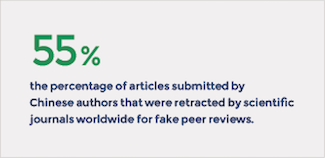 Peer review fraud is a relatively new phenomenon. It usually involves authors posing as their own peer reviewers and submitting made-up contact information for the supposed reviewer – a scam that publishers exposed by tracking the email addresses of author and reviewer to the same IP address. This type of fraud is on the rise and more often than not involves Chinese authors. In 2015, for instance, Britain-based publisher BioMed Central retracted 43 articles, including 41 from China. Later in the same year, Germany’s Springer retracted 64 papers, nearly all from Chinese scholars, while the Dutch publishing company Elsevier retracted nine medical science articles written by Chinese researchers. In what is said to be the largest single-incident retraction of journal publications in history, Springer Nature in 2017 retracted 107 articles in Tumor Biology published between 2012 and 2016, all of them authored by Chinese scholars from universities in Shanghai.
Peer review fraud is a relatively new phenomenon. It usually involves authors posing as their own peer reviewers and submitting made-up contact information for the supposed reviewer – a scam that publishers exposed by tracking the email addresses of author and reviewer to the same IP address. This type of fraud is on the rise and more often than not involves Chinese authors. In 2015, for instance, Britain-based publisher BioMed Central retracted 43 articles, including 41 from China. Later in the same year, Germany’s Springer retracted 64 papers, nearly all from Chinese scholars, while the Dutch publishing company Elsevier retracted nine medical science articles written by Chinese researchers. In what is said to be the largest single-incident retraction of journal publications in history, Springer Nature in 2017 retracted 107 articles in Tumor Biology published between 2012 and 2016, all of them authored by Chinese scholars from universities in Shanghai.
What this proliferation of fake peer reviews reflects is that fraud and corruption in Chinese academia are becoming increasingly sophisticated and organized. Science Magazine’s Mara Hvistendahl already described this trend in a 2013 study titled “China’s Publication Bazaar.” The article detailed a well-established and thriving academic black market industry, involving “shady agencies, corrupt scientists, and compromised editors – many of them operating in plain view.” The services offered by these corrupt merchants range from the tailored ghostwriting of research papers to the fabrication of research data or “simply buying a paper from an online catalog of manuscripts—often with a guarantee of publication.” As of 2013, fees ranged from USD $1,600 to USD $26,300, with publications in prestigious English-language journals commanding a much higher price.
The magnitude of these types of academic scams can be extreme, up to the extent that the entire journal may be a fake. In one 2013 incident, for instance, the Chinese police busted a crime ring that sold counterfeit copies of existing medical journals. The Economist reported that the “cost of placing an article in one of the counterfeit journals was up to USD $650, … purchasing a fake article cost up to USD $250. Police said the racket had earned several million yuan (USD $500,000 or more) since 2009. Customers were typically medical researchers angling for promotion.”
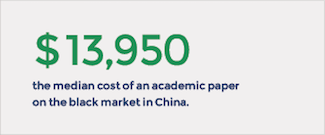 Hard data on covert activities like academic fraud are hard to obtain. But there is good reason to believe that fraudulent practices in Chinese academic publishing have increased in size and scope in recent years. Wuhan University, for example, has estimated that the country’s “industry of plagiarism, invented research and fake journals” grew five times in volume between 2007 and 2009 alone, and amounted to USD $150 million in 2009.
Hard data on covert activities like academic fraud are hard to obtain. But there is good reason to believe that fraudulent practices in Chinese academic publishing have increased in size and scope in recent years. Wuhan University, for example, has estimated that the country’s “industry of plagiarism, invented research and fake journals” grew five times in volume between 2007 and 2009 alone, and amounted to USD $150 million in 2009.
Recent anecdotal evidence is abundant. In 2016, the watchdog organization Plagiarism Watch, for instance, found that a medical journal based in Brazil enjoyed odd popularity among Chinese researchers, with 78 percent of the articles published in the journal in 2015 originating from China (a total of 2,056). Upon closer inspection, the organization discovered that many of the articles featured almost identical graphics and concluded that the plagiarized articles were likely the work of a third-party ghostwriting service.
Wide-spread plagiarism is not limited to little-known journals in Brazil. The use of anti-plagiarism software to cross-reference articles published between 2008 and 2010 in the prestigious Journal of Zhejiang University–Science, a publication endorsed by the National Natural Science Foundation of China, found that fully 31 percent of the examined articles contained “unoriginal material.” This alarmingly high rate of plagiarism sparked heated discussion among Chinese scholars about the reliability of the software, as well as possible measures to curb the trend.
These discussions have helped to create awareness and steer academic institutions towards adopting more rigorous methods to combat academic fraud. Increasing numbers of Chinese universities now use anti-plagiarism software, for instance. Rooting out academic corruption, however, does require much more fundamental reforms, including changes to China’s corruption-prone monetary incentive system for academic publishing.
Publication Rewards: A Driver of Academic Fraud
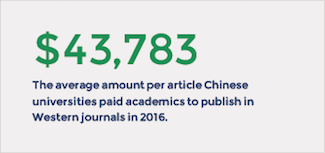 Unlike in most Western countries, academic publishing in China is often directly tied to material gains and therefore provides an ideal breeding ground for corrupt practices. In their quest for international reputation and global academic grandeur, many Chinese universities are incentivizing academics to publish with ever-increasing cash rewards. The amount of cash rewards can in some cases be as exorbitant as USD $165,000 for publications in prestigious Western journals. The average reward amount is lower, of course, and stood at USD $43,783 for natural science articles published in Western journals in 2016. But that is still an astronomical amount in a country in which 85 percent of professors earn less than USD $23,000.
Unlike in most Western countries, academic publishing in China is often directly tied to material gains and therefore provides an ideal breeding ground for corrupt practices. In their quest for international reputation and global academic grandeur, many Chinese universities are incentivizing academics to publish with ever-increasing cash rewards. The amount of cash rewards can in some cases be as exorbitant as USD $165,000 for publications in prestigious Western journals. The average reward amount is lower, of course, and stood at USD $43,783 for natural science articles published in Western journals in 2016. But that is still an astronomical amount in a country in which 85 percent of professors earn less than USD $23,000.
What is more, academic journal publications are often required for employment, promotions, the award of research grants, and even the award of doctoral degrees. Many Chinese universities require Ph.D. candidates to publish a set number of articles in “high-impact” journals in order to graduate. In other words, academic journal articles are a highly important currency in Chinese academia. Competition is fierce, with publications in less prominent journals barely making the cut.
In the final analysis, material publication incentives may have helped fuel the rapid expansion of China’s research output, but they are a double-edged sword, facilitating the spread of academic misconduct. As Chinese scholars Wei Quan et al. have noted in their study “Publish or impoverish,” publication rewards encourage Chinese academics to favor “fast research that leads to quick, cashable publications as opposed to long-term research.” In a small number of instances, these quick cashable results involve plagiarized or ghostwritten papers. It is perhaps no coincidence that most of the recently retracted articles were published in the medical field. For medical researchers, including clinical doctors, promotion is largely based on publications.
Cultural Aspects
Plagiarism and academic fraud can only thrive in a sociocultural environment that enables such corrupt practices. Despite the current anti-corruption campaign of the CCP, ordinary Chinese citizens live in an environment in which graft and corruption by public officials is commonplace. The fight against academic fraud is further impeded by disrespect for intellectual property rights in China. Cheap Chinese knock-offs, from pirated DVDs to counterfeit Gucci bags, are a well-known fact of modern life. But copyright infringements in China also include brazenly plagiarized news publications or TV shows. As CNBC’s Qian Chen recently noted, plagiarism is rampant in China’s state-controlled news media – the reporter found unattributed, word-for-word translations of almost all of her news stories in Chinese media shortly after publication. Chinese TV broadcasters, meanwhile, blatantly plagiarize popular Korean soap operas. All too often, such offenses are met with lenient official attitudes and overall public tolerance.
In the classroom, teachers do not do much to educate students about plagiarism and dissuade them from lifting other people’s work. This omission becomes apparent when Chinese students go abroad to study in Western countries and clash with Western concepts of plagiarism. The Confucian education model emphasizes the memorization and recitation of works produced by master scholars. In this context, Chinese students may regard writings and ideas as belonging to society, rather than being the intellectual property of individuals. As U.S. educators have noted, students from China and other Asian cultures do often not intend to violate academic conventions, but simply do not understand why plagiarism is immoral. Rooting out plagiarism will therefore be difficult without fundamental changes in Chinese teaching.
Reluctance by University Administrators to Punish Academic Corruption
That is not to say that Chinese academics are unaware of the problem. A recent 2017 survey of biomedical researchers, for instance, found that more than 70 percent of the scholars thought that Chinese authorities are not doing enough to curb academic fraud. The finding illustrates that upholding academic integrity has until recently not been a high enough priority for administrators and regulators in China’s education system. In 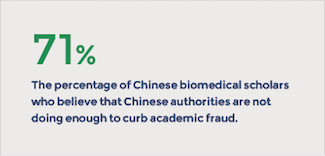 fact, taking action against corrupt academics was frequently discouraged to avoid negative headlines and the “loss of face” (mianzi). Formal investigations and punishment were often only initiated under pressure, when the problem at hand attracted too much media attention. In one example, Xi’an Jiaotong University for a long time turned a blind eye towards allegations that one of their professors had published fabricated research. It took a two-year independent investigation by six professors to push the issue. When the professors exposed 30 forged research papers, the university reluctantly dismissed the corrupt professor in 2010.
fact, taking action against corrupt academics was frequently discouraged to avoid negative headlines and the “loss of face” (mianzi). Formal investigations and punishment were often only initiated under pressure, when the problem at hand attracted too much media attention. In one example, Xi’an Jiaotong University for a long time turned a blind eye towards allegations that one of their professors had published fabricated research. It took a two-year independent investigation by six professors to push the issue. When the professors exposed 30 forged research papers, the university reluctantly dismissed the corrupt professor in 2010.
Official Responses to the Academic Integrity Crisis
To some extent, this reluctance of Chinese universities to punish academic misconduct is owed to the fact that the education system is plagued by a considerable degree of corruption. The award of large research grants, for example, is said to be often based on personal connections to party officials rather than academic merit. Reports about other corrupt practices like the embezzlement of research funds surface with some frequency. The recent wave of academic fraud and article retractions, however, has rattled Chinese academia to the extent that the problem can no longer be ignored. Over the past three years, the government and academic institutions have stepped up the fight against academic corruption and adopted a number of official anti-fraud directives:
In 2015, the China Association for Science and Technology (CAST), for instance, issued a national directive for international academic publishing, titled “Five Codes of Conduct for Authors Who Publish in International Journals” (在国际学术期刊发表论文的“五不”行为守则). The document includes very direct guidelines:
- Do not engage a third party for ghostwriting services.
- Do not submit a paper through a third party.
- Do not engage a third party to revise the content of research papers.
- Do not provide fake information for author-suggested reviewers.
- Do not violate authorship criteria.
The following year, the Ministry of Education published more far-reaching guidelines on the prevention and punishment of academic misconduct for colleges and universities (高等学校预防与处理学术不端行为办法, 2016). In the document, the ministry urges institutions to advance oversight and educate staff about academic misconduct. It directs universities to establish systems for the prevention and punishment of academic fraud. Specific steps include:
- Refine the academic assessment and rewards system
- Encourage innovation, accept failure
- Build a record of academic integrity
- Enhance education and training
- Increase transparency in the administration of research
- Establish academic misconduct reporting mechanisms
The document also outlines definitions of academic misconduct and specifies concrete administrative procedures for the investigation and handling of such misconduct, including dismissal, review and appeal mechanisms.
In 2017, measures against fraud were stepped up even further. Several government agencies launched investigations into peer review fraud resulting in 376 academics being banned from conducting research, while their qualifications and research grants were revoked. CAST also published another directive, titled “self-disciplinary ethical standards for science and technology workers” (科技工作者道德行为自律规范, 2017).
All of these measures are promising signs that the Chinese government is starting to treat academic fraud with the seriousness the problem deserves. To fully root out corruption, however, it will be necessary to disentangle academic pursuit from material gains. The sky-high gap between professor salaries and publication rewards remains a major problem that the government needs to address, either by curbing cash rewards or by upping teacher salaries. In addition to the rigorous and uncompromising punishment of academic fraud, the government would also be well-advised to create positive incentives for research integrity, rather than merely rewarding research output, as measured in journal publications.
In another encouraging development, hundreds of college professors and university officials in 2015 resigned from their lucrative corporate positions after the government tightened regulations on part-time jobs held by CCP officials. This is a positive step towards reducing conflicts of interest. An even more meaningful step, however, would be the total separation of academic and administrative appointments. It is common for university professors in China to simultaneously hold administrative government positions – in 2009, it was reported that no less than 90 percent of China’s top award-winning teachers held such positions. This interlinkage between academia and bureaucracy inevitably casts a shadow on independent oversight and the fair use of power, given the vested interests in different areas.
The stakes in China’s anti-corruption drive are high. If Chinese academia continues to be undermined by conflicts of interests and academic integrity remains corrupted by materialism, it will be difficult to establish China as a truly world-class research location. As China is transitioning to a knowledge economy and a leading scientific research producer, research integrity and reputation will become increasingly important currencies. Crucially for curbing academic fraud in China, it is important that Chinese society adopts strong cultural norms regarding corruption and plagiarism, and starts to emphasize research more for the sake of building knowledge, and less like a commodity and means towards material ends. Without such a cultural shift, the impact of any formal anti-fraud legislation could be limited.
